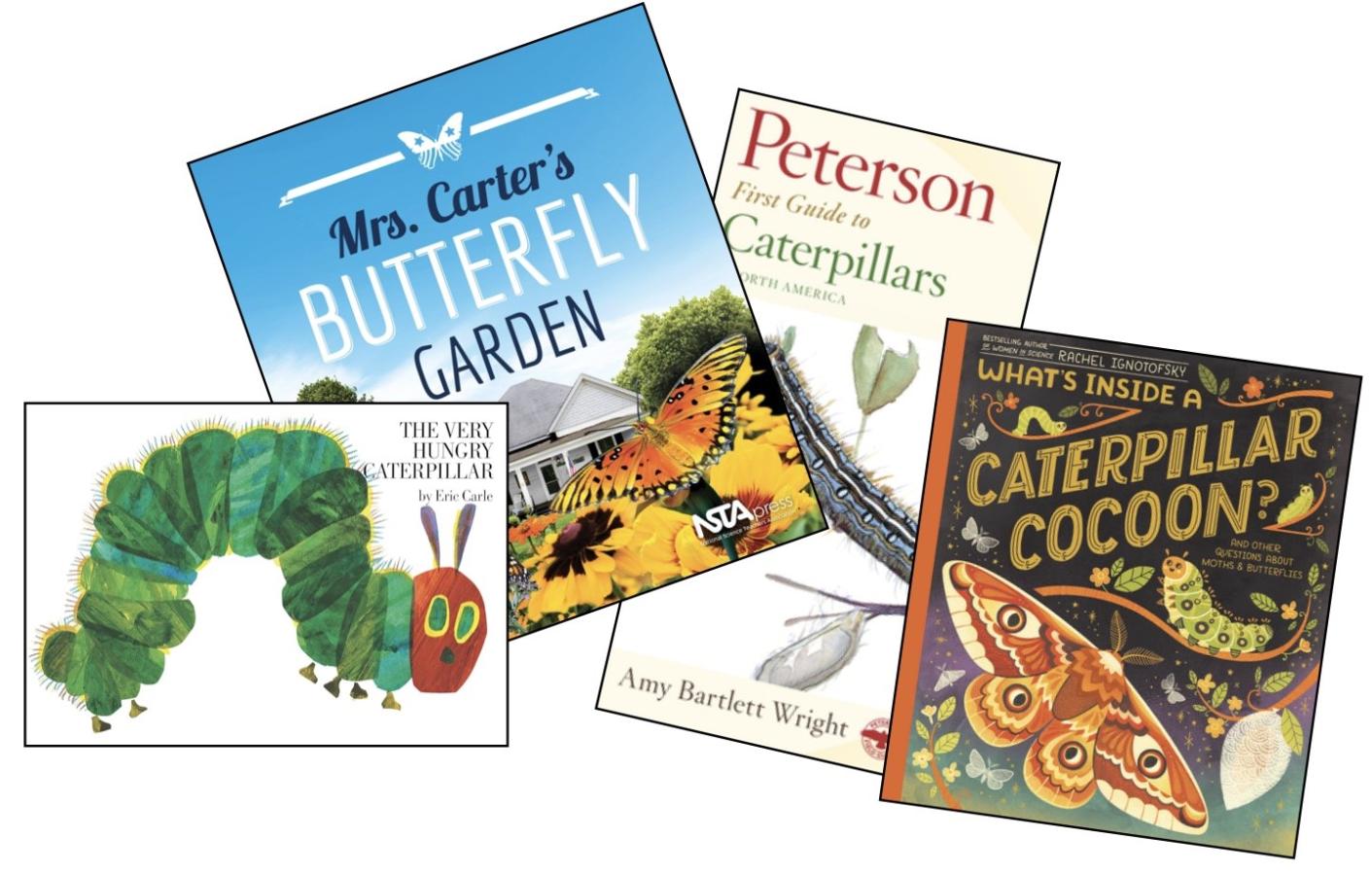The Very Hungry Caterpillar, Butterflies, and More About Moths!
By Peggy Ashbrook
Posted on 2024-03-12

Disclaimer: The views expressed in this blog post are those of the author(s) and do not necessarily reflect the official position of the National Science Teaching Association (NSTA).
In the spring, many teachers plan to show a butterfly life cycle to their students, often by purchasing caterpillars to raise in the classroom. Planting food plants for local butterflies and moths and searching for their babies (also known as caterpillars or larvae) connects classroom observations of purchased caterpillars with children’s own environment (see NSTA Blog posts in the Additional References section below). Reading trade books aloud supports both literacy and science learning. Here is a short list of wonderful books about butterflies and moths, beginning with Eric Carle’s The Very Hungry Caterpillar.
Carle’s 1969 children’s book, The Very Hungry Caterpillar, is a beloved book for many reasons, beginning with the brilliant colors and tactile feel of his artwork. This fun book engages readers in both an unlikely scenario and math concepts, as the pages grow bigger and bigger while the number of favorite human food items eaten by the caterpillar increases. And of course, there’s a happy ending.
It is an art book, a math book, and a science book. It is also a book for learning about media literacy because it provides a good place to begin talking about what is real and what is imaginary and how we can find out what happens in nature.

As a teacher educator who focuses on early childhood science education, I change one word in The Very Hungry Caterpillar when I read it aloud, substituting the word chrysalis for the word cocoon. To paraphrase comedian Steve Martin, “those scientists have a different word for everything!” The word scientists who use the English language have for the pupa stage of a butterfly is chrysalis, and the word that is used for the pupa stage of a moth is cocoon.
Not a big deal to confuse the two terms occasionally, but why not offer this rich language to children? We differentiate between arms and legs, fur and feathers, and leaf and petal. Doing so helps children describe their world and begin to understand the wonderful diversity among living organisms, as well as the concept of parts of an organism having specific use and purpose (NGSS Core Idea LS1.A). Children can say Tyrannosaurus rex and other multi-syllable dinosaur names, and they are able to say chrysalis.
Here are a few other beautiful and fun books about the life cycle of the insects butterflies and moths. My favorite is What’s Inside a Caterpillar Cocoon? And Other Questions About Moths and Butterflies by Rachel Ignotofsky. So many questions are addressed and investigated in this book! Children will enjoy discovering familiar and new caterpillars in the gorgeous illustrations, and will see the life cycles of butterflies and moths in side-by-side illustrations that begin to cement the way these animals are alike and different. And yes, the pupa stage of a moth is described as cocoon and that of a butterfly is called a chrysalis.

Moths and butterflies are both insects, in the same Order, Lepidoptera. Caterpillars of both moths and butterflies are listed in Amy Bartlett Wright’s handy identification book, Peterson First Guide to Caterpillars of North America. The larval food sources are listed for each species, so if your children bring a caterpillar to school, you can find out what type of nice green leaf it needs to eat.
Use your students’ curiosity about caterpillars and excitement when a butterfly emerges from its chrysalis to expand their understanding of all kinds of animals.
Resources: Children’s Books
Carle, E. 1969. The very hungry caterpillar. New York, NY: Penguin Random House.
Himmelman, J. 1998. A luna moth's life (Nature upclose). Chicago, IL: Children’s Press.
Ignotofsky, R. 2023. What’s inside a caterpillar cocoon? And other questions about moths and butterflies. New York, NY: Random House Children’s Books.
Koontz, R. 2009. What’s the difference between a butterfly and a moth? Bloomington, MN: Picture Window Books.
McCloskey, K. 2023. Caterpillars: What will I be when I get to be me? TOON Level 1. New York, NY: TOON Books.
Pallotta, J. 2019. Not a butterfly alphabet book: It's about time moths had their own book!. Watertown, MA: Charlesbridge.
Petty, D. 2021. Moth & butterfly: Ta-da. New York, NY: Nancy Paulsen Books.
Pringle, L. 2014. The secret life of the woolly bear caterpillar. New York, NY: Astra Young Readers.
Rich, S. 2014. Mrs. Carter's butterfly garden. Richmond, VA: NSTA Press.
Simon, S. 2011. Butterflies. New York, NY: HarperCollins.
Wright, Amy Bartlett. 1998. Peterson first guide to caterpillars of North America. Boston, MA: Houghton Mifflin.
Additional Resources
Haavind, S., and F. Reichsman. August 24, 2023. Learning science practices with moths and collaborative software. The Concord Consortium Blog.
https://concord.org/blog/learning-science-practices-with-moths-and-collaborative-software/.
National Moth Week. Celebrated yearly during the last full week of July.
https://nationalmothweek.org/?goback=.gde_1791816_member_113070160.
Posey, M. March 18, 2015. Following children’s interests; following a caterpillar over winter. NSTA Blog. https://www.nsta.org/blog/following-childrens-interests-following-caterpillar-over-winter.
Ashbrook, P. June 16, 2010. Update on the success of using local butterflies. NSTA Blog. www.nsta.org/blog/update-success-using-local-butterflies.
NSTA Kids. Trade books dedicated to nurturing the wonder and curiosity inherent in our youngest learners! www.nsta.org/bookstore/nsta-kids.

Peggy Ashbrook is an early childhood science educator and writer living in Alexandria, Virginia, and helping to raise her four-year-old grandchild. She wrote NSTA’s The Early Years column from 2005 to 2021.
General Science Interdisciplinary Life Science Teaching Strategies Early Childhood


